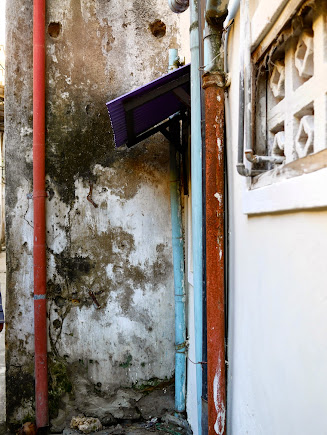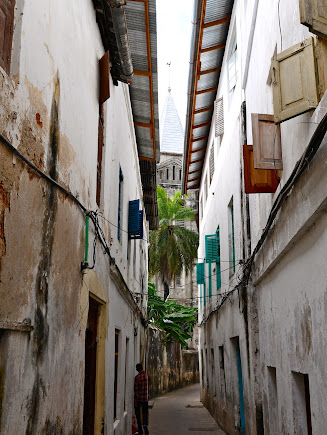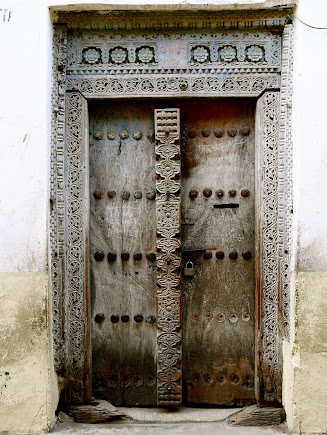The Chinese Dream had seen better days than the one we rode out of Baobab Valley headed for the Tanzanian coast. Within a few hours of riding Mike dropped his chain another couple of times and it looked as droopy as could be. We stopped at every motorbike shop we saw, but couldn’t find a chain the right gauge and length for Mike’s bike. It was only 300 miles to Dar Es Salaam, so the Chinese Dream was just going to have to suck it up.
The ride into Dar Es Salaam was death defying. I’d forgotten what it was to ride a motorbike into a crowded, seething, cook pot of an African capital city. I was quickly reminded with the first few near misses by trucks and buses careening along. There seems to be a direct relationship between the degree of flamboyancy of the bus paint job and the risk tolerance of the driver. I hate having really sparkly busses behind me.
The road was utterly filled with huge trucks and buses and hardly anything else. For hundreds of miles the asphalt had deep depression tracks that look like a really heavy truck drove on it before the road was finished. The deep tracks and adjacent ridges make it really difficult to move laterally in a lane adding to the peril on a motorbike. It feels dangerous for me on the 650, so I can imagine how it feels for Mike on the 250 with a dodgy chain. As we neared Dar Es Salaam and traffic slowed, we passed trucks on the road shoulder, the adjacent roadside market, or anywhere else that would allow us to get out onto open highway and avoid being a semi-truck sandwich.

Dar Es Salaam means ‘Place of Peace’ in Arabic, but we found the congested city to be nothing of the sort. Mike, Jamie and I all tucked into a single dingy room in a hotel nearby the ferry port and locked our bikes away in a steel gated area outside. As we wandered the heart of the city, some charm became apparent with Indian street kitchens and restaurants preparing and serving delicious dishes right on the sidewalk.
The next morning we found the ferry to Zanzibar Island and rolled our bikes into the cargo hold amidst the chaos of large wheeled luggage movers thundering up and out of the ship to the rowdy shouts and cart riding antics of the porters hustling about. We sped across the channel that separates Zanzibar from the mainland on a course that had us slicing through the ocean swells at an oblique angle and giving the boat a good roll from time to time. At the port of Stone Town we quickly found ourselves in a maze of narrow alleyways with no indication of the way out. Before long, we were putting along through a crowded marketplace and feeling as though we’d ridden into a scene from an Indiana Jones movie.
Zanzibar’s Stone Town has a gritty neighborhoody feel to it in a way that makes a stranger comfortable wandering around. A tangled network of narrow streets and alleyways connect small stores, bazaars, mosques, workshops, restaurants and squares. Windows are so close to one another on opposite sides of the streets that you could borrow a cup of sugar from your neighbor without coming downstairs.

Stone Town was historically a center of spice trade and slave trade during the 19th century and became a British protectorate in 1890. Diverse elements from Arab, Persian, Indian, European, and African cultures are apparent in the architecture of the city and led to a designation as a UNESCO world heritage site in 2000. The main construction material is coral, which is very friable, and most of the buildings are in deteriorating condition.
There are more than 200 carved wooden doors constructed and ornamented in Indian or Islamic styles.

Kids ran by us chasing after one another and laughing. They ran like they know every blind alley and turn and in this labyrinth that we quickly found ourselves lost within.
Jamie and I walked around and soaked it all up.
A busy marketplace pulsed with the business of the day.
We stopped at one busy square full of men of all ages milling about. Some of the old fellas have been coming to the same square, drinking coffee and playing dominoes for decades. These old guys had a distinguished air to them and you could sense a hierarchy of sorts amongst them.
It was one of those places that it feels like you have no right to intrude upon and feel a bit of a voyeur. We were grateful for the brief welcome that we was extended to us gawking tourists.
After stopping at a few motorbike shops to no avail Mike finally got a new chain in the nick of time. He was barely able to convince the old one to stay on the chain ring for more than 20 minutes at a stretch by the time we limped into the bike shop. While the shop didn’t have a chain that was long enough, they were able to cut some extra links into one that they had on hand.
From Stone Town, we made for the far side of the island which is exposed to open swell from the Indian Ocean. We were far north enough that the swell shadow created by Madagascar should no longer be a problem as it is for much of the Mozambique coastline.
We found the east side of Zanzibar the exclusive domain of kite surfers rather than the wave riding type. A barrier coral reef a couple kilometers from shore created a perfect, shallow zone of beautiful turquoise water with very little swell energy to deal with. On the horizon, we could see the whitewater where waves were crashing, unloading their full power long before they reached the shoreline.
Jamie and I spent our nights in a sand floor bungalow with walls of woven dried palm leaves and a thatched roof. The white sand was so fine that it created this wonderfully soft, milky slurry as tiny waves stirred the water at the shoreline. When I scooped up handfuls of sand I it was so sticky due to the fine clay-size particles that I could press it into a ball in my fist.
Jamie and I explored up and down the beach on the bike and wandered the tidal zone at low tide looking for treasures in the endless rippled sandy flat as local folks went about their low tide business. Zanzibar is a very friendly place to visit and a far cry from the hectic nature of Dar Es Salaam on the mainland. The phrase Hakuna Matata (no worries) is always quick on the lips of locals as they deal with the European tourists that swarm about the island.
There is something incredibly free feeling about flying along a strange beach on a motorbike. It feels like the little machine thumping along beneath you could take you anywhere you might have want to wander.
The whole setting was idyllic and very relaxing but I was consumed with the thought of searching for waves out on the reefs that teased us with each look to the horizon with billows of whitewater. The local kite surf shop had a couple of surfboards kicking around that we could use and the guys who worked there tried to describe how to find a break out on the reef about 45 minutes away by boat. Unfortunately, all of the kite surf guys were busy teaching lessons every day, so Mike and I were on our own to find a boat and the way to the surf spot. I talked to half a dozen fishermen over the course of two days and got a mix of misunderstanding, empty promises, and hakuna matatas. I finally employed the services of our host at the Bungalows, Simba (I swear I’m not just making up names and words from the Lion King). Simba found us a guy who could run us out the reef for a reasonable fee the following afternoon. I was stoked – after days of looking we now had boards to ride and a way to the surf.
The guys with the boat were an hour late after having to deal with getting some water in the petrol and they hardly spoke a word of English. No problem, I thought, I’ve got Simba who speaks perfect English and he can explain them what we want to do and where we want to go. After a lengthy back and forth on the sand, I was confident that we were all on the same page and off we went.
It didn’t take long after setting off to find out that we were not even reading the same book. They ran us straight out eastward to the reef, stopped the boat and looked at Mike and I to do something. The directions that we’d communicated to the surf spot were to motor about 45 minutes south along the reef towards a narrow pass, where two big blocks of coral sit atop the main reef. Sitting in the boat, Mike and I looked out at a chaotic mess of waves breaking every which way on the shallow reef, and then we stared back and the guys and put our hands up. During the next hour, we pointed, and drew pictures in the air with our fingers, and called Simba on their cell phone to try to communicate where we wanted to go. They finally seemed to get the picture with smiling nods of understanding. Then one of them pointed to the gas can to indicate that there wasn’t enough fuel to make it where we wanted to go. Fantastic. We were feeling defeated as the new plan seemed to be to simply head back to shore and we knew that ther wouldn’t have enough time to find gas and go back out again.
After much discussion between our two boatmen, we made a turn south. They’d decided to chance it on the gas we had. Mike and I scanned the horizon hard and from time to time we’d imagine that we saw a peeling wave. You start playing a game with yourself of ‘maybe that’s it’ as one surf mirage after another rolls by. Others had surfed here, so we weren’t exactly in uncharted territory, but to us every chunk of reef was new. We were just following a few clues and it felt like the stuff of real surf exploration. When two square-looking dark shapes appeared far off in the distance, our hopes grew that we were in the right vicinity. We were sitting so low in the little boat, it was really difficult to identify which way to paddle.
Mike and I jumped out of the boat and paddled toward the reef, having very little idea what we were headed for. There was no clear channel on the inside and we battled our way through whitewater. It’s always a bit unnerving jumping out of a boat miles from shore and paddling into the unknown. The primary danger was that we could be sucked onto a shallow part of the reef before we knew it to find head-high waves breaking on us in knee-deep water. What we found beyond the reef was about as good as a mediocre 5-foot day at Ocean Beach in San Francisco. The wave had plenty of power an you could find a section or two to do a couple turns, but it really didn’t feel like we were in the right place. It just didn’t seem like a surf spot that anyone would venture 15 kilometers in a boat to ride. In fact, we wondered whether we were the first people ever to surf this piece of reef entirely.
We came back to the boat and pointed the guys to the other side of the two big blocks of coral. After motoring about half a kilometer north, a fairly defined shoulder of a wave peeling to the right came into view with something of a channel running alongside it. We watched a few waves, and while our vantage point was still poor, I became convinced that this was the wave we had been seeking. Somehow we’d missed it on our first pass by headed south. Mike and I jumped out of the boat and paddled out to have a closer look.
The paddle out was easier than the last attempt with a channel of deep water to use. The wave peaked up near the two exposed coral blocks and peeled for about 50 yards before closing out on a shallower part of the reef. There was lots of junky short-period windswell mixed in with some longer period lines that showed the real potential of this slice of reef. On the lined up ones, you could run down the line and do a couple of good cutbacks along the way. Mike and I surfed until the sun was on its way down then made our way back to the boat, happy to find the guys on the boat pretty close to where we’d left them. We’d nearly failed, and this was as much effort as I’ve ever put into getting a halfway decent surf session. We never actually ascertained whether or not we were surfing the break that had been described by the kite surfers, but that didn’t really matter. Half the fun was just finding some waves to ride in a strange place.
Mike had to be off on a flight from Dar in two days, which meant catching the ferry back to the mainland the following afternoon. We arrived in Stone Town on the other side of the island 2 hours before the last ferry of the day was to leave port. We rolled up to a guest house, chatted to a guy who happened to be sitting outside about having a bike to sell and within 20 minutes there were half a dozen dudes there arguing about the who was going to buy it. Within an hour, the bike was sold, papers signed, and money changed hands, and Mike was off to the ferry. Gosh I love Africa.
Mike had flown to Cape Town the day after he finished teaching school, bought a cheap Chinese-manufactured 250cc dirt bike, bungeed his backpack to the seat, and rode the thing to death across 8 countries in southern Africa. Everyone who knew anything about bikes swore that he’d never make out of South Africa on such a cheap ride, yet there we stood on the island of Zanzibar, 6 thousand miles and two and a half months later. He even rode the original knobby tires the entire way. I don’t know anyone else who would have made it happen. The guy has a high adventure threshold. It’s a long way back to Europe and I’m going to miss seeing his headlight in the rear-view mirror.
so jamie, in that last pic were on your way up, down, or rebelling? 🙂 great stories guys!
you look really lame sitting on that boat and ordering around those 2 guys to find your surf spot. Did you even Thank them?
justsaying, thanks for providing Gary with a reminder of the type of negativity that he’s escaping on this trip.
Keep it up, Gary!
@justsaying dude! that was my best trying to look cool on a boat face!
The guys were pretty stoked even after all of our communication debacles since they earned about twice what they would have fishing that afternoon motoring some silly tourists around.
@ kelly – Jamie was pretty focused on the jazz hands.